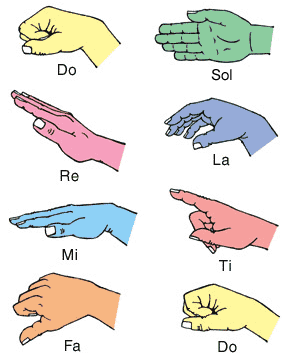solfege

Solfege (solfeggio in Italian; solfège in French) is a method of sight reading and vocal training which uses the syllables 'DO, RE, MI, FA, SOL, LA, TI, DO'. Two common systems are moveable-DO solfege and fixed-DO solfege.
Moveable-Do solfege is a method of solfege in which the root or tonic of the key is always 'DO'. This method focuses on understanding the melodic functions common to each key.
In fixed-DO solfege the note 'C' is always DO, regardless of the key. This system focuses on intervallic hearing.
The hand signs cover an octave of a major scale. Each is performed in a different vertical position – the first Do is at waist level, then each of the following signs is higher as the scale rises in pitch, with the last Do coming at eye level. Additional signals have been devised for the altered tones – raised Do, flatted Re, etc.
There's a long history of relating the notes of the scale to the body, going back more than a thousand years to Guido of Arezzo and the 'Guidonian hand' image that presented the musical scale on various joints of each finger. The solfege signs were devised by the eighteenth century minister and musician John Curwen (1816–1880).


